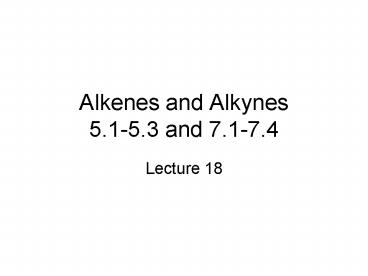Alkenes and Alkynes 5'15'3 and 7'17'4 - PowerPoint PPT Presentation
1 / 22
Title:
Alkenes and Alkynes 5'15'3 and 7'17'4
Description:
Unsaturated hydrocarbon: Contains one ... Cis,Trans Isomerism in Alkenes ... bonds, each of which can show cis,trans isomerism, 2n stereoisomers are possible. ... – PowerPoint PPT presentation
Number of Views:54
Avg rating:3.0/5.0
Title: Alkenes and Alkynes 5'15'3 and 7'17'4
1
Alkenes and Alkynes5.1-5.3 and 7.1-7.4
- Lecture 18
2
Unsaturated Hydrocarbons
- Unsaturated hydrocarbon Contains one or more
multiple bonds. - Alkene Contains a carbon-carbon double bond and
has the general formula CnH2n. - Alkyne Contains a carbon-carbon triple bond and
has the general formula CnH2n-2.
3
Unsaturated Hydrocarbons
- Arenes Benzene and its derivatives (Ch 21-22)
- The phenyl group is not reactive under any of
the conditions we describe in Ch 6.
4
Structure of Alkenes
- A double bond consists of
- one sigma bond formed by the overlap of sp2
hybrid orbitals and one pi bond formed by the
overlap of parallel 2p orbitals. - the two carbon atoms of a double bond and the
four atoms bonded to them lie in a plane, with
bond angles of approximately 120.
5
Structure of Alkenes
- it takes approximately 264 kJ (63 kcal)/mol to
break the pi bond in ethylene that is, to rotate
one carbon by 90 with respect to the other so
that there is no overlap between 2p orbitals on
adjacent carbons.
6
Cis,Trans Isomerism in Alkenes
- Cis,trans isomers Isomers that have the same
connectivity but a different arrangement of their
atoms in space due to the presence of either a
ring or a carbon-carbon double bond.
7
IUPAC Nomenclature
- 1. Number the longest chain of carbon atoms that
contains the double bond in the direction that
gives the carbons of the double bond the lowest
numbers. - 2. Locate the double bond by the number of its
first carbon. - 3. Name substituents.
- 4. Number the carbons, locate and name
substituents, locate the double bond, and name
the main chain.
8
Common Names
- Despite the precision and universal acceptance of
IUPAC nomenclature, some alkenes, particularly
low-molecular-weight alkenes, are known almost
exclusively by their common names.
9
Common Names
- the common names methylene, vinyl, and allyl are
often used to show the presence of the following
alkenyl groups
10
The Cis,Trans System
- Configuration is determined by the orientation of
atoms of the main chain.
11
The E,Z System
- Uses priority rules (Chapter 3).
- If groups of higher priority are on the same
side, the configuration is Z (German, zusammen). - If groups of higher priority are on opposite
sides, the configuration is E (German, entgegen).
12
The E,Z System
- Example Name each alkene and specify its
configuration by the E,Z system.
13
Cis,Trans Isomerism
- Cycloalkenes
- In small-ring cycloalkenes, the configuration of
the double bond is cis. - These rings are not large enough to accommodate a
trans double bond.
14
Cis,Trans Isomerism
- Trans-cyclooctene is the smallest trans
cycloalkene that has been prepared in pure form
and is stable at room temperature. - The cis isomer is 38 kJ (9.1 kcal)/mol more
stable than the trans isomer. - The trans isomer is chiral even though it has no
chiral center.
15
Dienes, Trienes, and Polyenes
- For alkenes containing two or more double bonds,
change the infix -en- to -adien-, -atrien-, etc. - Those containing several double bonds are often
referred to more generally as polyenes.
16
Dienes, Trienes, and Polyenes
- For alkenes with n double bonds, each of which
can show cis,trans isomerism, 2n stereoisomers
are possible.
17
Physical Properties
- Alkenes are nonpolar compounds.
- The only attractive forces between their
molecules are dispersion forces. - The physical properties of alkenes are similar to
those of alkanes.
18
Nomenclature
- IUPAC use the infix -yn- to show the presence of
a carbon-carbon triple bond. - Common names prefix the substituents on the
triple bond to the word acetylene.
19
Cycloalkynes
- Cyclononyne is the smallest cycloalkyne isolated.
- It is quite unstable and polymerizes at room
temp. - The C-C-C bond angle about the triple bond is
approximately 155, indicating high angle strain.
20
Physical Properties
- Similar to alkanes/alkenes of comparable
molecular weight and carbon skeleton.
21
Acidity
- The pKa of acetylene and terminal alkynes is
approximately 25, which makes them stronger acids
than ammonia but weaker acids than alcohols
(Section 4.1). - Terminal alkynes react with sodium amide to form
alkyne anions.
22
Acidity
- Terminal alkynes can also react with sodium
hydride or lithium diisopropylamide (LDA). - Hydroxide ion is not a strong enough base to
convert a terminal alkyne to an alkyne anion.































